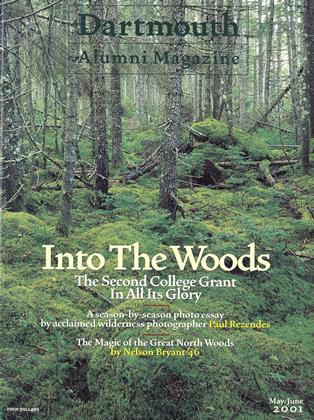The College redraws the campus map to chart its future academic direction and growth.
IN ITS FIRST YEARS, THE Dartmouth College campus consisted of little more than a collection of crude structures centered around a common. The tree stumps would not be cleared from this space until the 1830s. Seven decades later Dartmouth had expanded to both sides of the Green, although not much beyond that. Today we have spread to the Connecticut River on the west, to Park Street on the east and to Lebanon Street on the south.
The College surely will continue to grow. Indeed, we are in a period of substantial new construction and renovation. But as we grow we seek to protect the aesthetic character of the campus, maintain a sense of community and connection, and preserve and protect the vitality and attractiveness of the Hanover community. These principles, combined with clear academic objectives and the guidance of campus master planner Lo-Yi Chan '54, direct our expansion.
Our first objective has been to provide faculty and students with space that meets their needs for teaching, learning and research. This includes providing more "smart" classrooms equipped with technology, offices for faculty and space for active emeriti faculty, labs and studios equipped to handle the demands of modern science and art, an excellent library system, and residential and social spaces that contribute to the learning environment.
Over the past few years we have built or renovated several of our science facilities, including Burke chemistry laboratory, Sudikoff computer science laboratory and the Fairchild Science Center. However, the life sciences, engineering and mathematics still urgently need more and better space.
Dartmouth's arts programs are also overcrowded. The Hopkins Center, nearly 40 years old, requires renovation and expansion. Currently, the Hop and the Hood Museum house their own programs as well as four academic departments. Enrollments and majors in these arts departments continue to increase, as do the size of the collection in the Hood Museum and the number of programs offered by the Hop.
We recently renovated 105 Dartmouth—where generations of Dartmouth students have attended lectures—and restored it to its former glory. But the general condition of Dartmouth Row requires attention. These buildings remain important symbols as well as centers for our intellectual vitality, and the offices and classrooms need major renovation.
A second set of objectives guiding expansion includes the desire to bring together departments that have been separated, to cluster similar departments to encourage collaborative and interdisciplinary work, and to provide additional space for new and expanding programs. Thus, we expanded the Fairchild Science Center for the physical sciences, renovated Silsby for many of the social science departments and will build Kemeny Hall for the mathematics department, which has been divided among three different buildings for far too long. The life sciences building will serve the department of biological sciences in the arts and sciences as well as genetics and related programs in the Medical School. The newly established Humanities Center needs a dedicated facility, as does the Dickey Center for International Understanding. These centers, along with the Rockefeller Center for the social sciences and the Ethics Institute, provide an intellectual focus for faculty and students in a range of disciplines.
Our nonacademic facilities needs are also significant. In November the board of trustees approved the siting of two residential clusters, one north of Maynard Street and the other on Tuck Drive, to relieve overcrowding on campus and allow more students to live on campus. We just opened Whittemore Hall at the Tuck School, and we are building housing for no graduate students. Alumni Gym and Thayer Dining Hall need renovations. In addition, we need more social, dining and recreational space for students.
A final piece of our master planning relates to the town of Hanover. Last year Dartmouth acquired a parcel of land south of Lebanon Street when an investor decided to sell his properties as a block. Approximately 100 of our students lived there. We are currently in negotiations with the local school district to acquire its downtown site in return for Dartmouth property on Lyme Road. We are not interested in expanding the campus any further into the town; we want to maintain Hanover as a town and protect its special character. My focus has been to bring students back to campus and provide more opportunities for faculty and staff to move to Hanover. These are critical elements in reaffirming our commitment to being a residential college.
Dartmouth will continue to grow, but with an eye to both our history and our long-term strengths. Our challenge today is to maintain the character and intimate nature of the Dartmouth campus while we continue to expand to meet the needs of our students and faculty—to strengthen our academic programs while retaining the special qualities that mark our campus.
 View Full Issue
View Full Issue
More From This Issue
-
 Feature
FeatureA Life in the Wild
May | June 2001 By NELSON BRYANT ’46 -
 Feature
FeatureShooting the Grant
May | June 2001 By BEN YEOMANS -
 Feature
FeatureVoices in the Wilderness
May | June 2001 By Jennifer Kay '01 -
 Feature
FeatureTHE GREAT NORTH WOODS
May | June 2001 By Michelle Chin '03 -
 Cover Story
Cover StoryNorthern Exposure
May | June 2001 -
 Sports
SportsThe Sporting Life
May | June 2001 By Lily Maclean ’01
President James Wright
-
 Article
ArticleVaried Experiences, Common \alues
DECEMBER 1999 By President James Wright -
 Article
ArticleWhere Do We Go From Here?
JANUARY 2000 By President James Wright -
 Article
ArticleThe Price of Excellence
MAY 2000 By President James Wright -
 Article
ArticleAt Home On Campus
Nov/Dec 2000 By President James Wright -
 The President
The PresidentA Tragic Loss
Mar/Apr 2001 By President James Wright -
 Article
ArticleThe Gift of Education
May/June 2002 By President James Wright







